IoT-Based Wireless System for Gait Kinetics Monitoring in Multi-Device Therapeutic Interventions
Abstract
1. Introduction
2. Materials and Methods
2.1. Statement of Human and Animal Rights
2.2. Subject and Study Design
2.3. Insole Pressure Sensor
2.4. Microcontroller and Circuit Prototyping
2.5. Communication Protocol
2.6. Experimental Setup
2.7. Data Processing
2.8. Statistical Analysis
3. Results
4. Discussion
5. Conclusions
Author Contributions
Funding
Institutional Review Board Statement
Informed Consent Statement
Data Availability Statement
Acknowledgments
Conflicts of Interest
References
- DeSilva, J. Walking through Human Evolution: First Steps: How Upright Walking Made Us Human; HarperCollins Publishers: New York, NY, USA, 2021. [Google Scholar]
- Sutherland, D.H. The evolution of clinical gait analysis Part I: Kinesiological EMG. Gait Posture 2001, 14, 61–70. [Google Scholar] [CrossRef]
- Sutherland, D.H. The evolution of clinical gait analysis: Part II Kinematics. Gait Posture 2002, 16, 159–179. [Google Scholar] [CrossRef]
- Baker, R. The history of gait analysis before the advent of modern computers. Gait Posture 2007, 26, 331–342. [Google Scholar] [CrossRef]
- Bloem, B.R.; Okun, M.S.; Klein, C. Parkinson’s disease. Lancet 2021, 397, 2284–2303. [Google Scholar] [CrossRef] [PubMed]
- Colver, A.; Fairhurst, C.; Pharoah, P.O.D. Cerebral palsy. Lancet 2014, 383, 1240–1249. [Google Scholar] [CrossRef]
- Tahir, A.M.; Chowdhury, M.E.H.; Khandakar, A.; Al-Hamouz, S.; Abdalla, M.; Awadallah, S.; Reaz, M.B.I.; Al-Emadi, N. A systematic approach to the design and characterization of a smart insole for detecting vertical ground reaction force (vGRF) in gait analysis. Sensors 2020, 20, 957. [Google Scholar] [CrossRef] [PubMed]
- Wang, L.; Jones, D.; Chapman, G.J.; Siddle, H.J.; Russell, D.A.; Alazmani, A.; Culmer, P. A review of wearable sensor systems to monitor plantar loading in the assessment of diabetic foot ulcers. IEEE Trans. Biomed. Eng. 2019, 67, 1989–2004. [Google Scholar] [CrossRef] [PubMed]
- SensorMedica. FlexinFit. Available online: https://www.sensormedica.com/en/flexinfit/ (accessed on 23 June 2024).
- Lynall, R.C.; Zukowski, L.A.; Plummer, P.; Mihalik, J.P. Reliability and validity of the protokinetics movement analysis software in measuring center of pressure during walking. Gait Posture 2017, 52, 308–311. [Google Scholar] [CrossRef] [PubMed]
- Vallabhajosula, S.; Humphrey, S.K.; Cook, A.J.; Freund, J.E. Concurrent validity of the Zeno walkway for measuring spatiotemporal gait parameters in older adults. J. Geriatr. Phys. Ther. 2019, 42, E42–E50. [Google Scholar] [CrossRef]
- Granja Domínguez, A.; Romero Sevilla, R.; Alemán, A.; Durán, C.; Hochsprung, A.; Navarro, G.; Páramo, C.; Venegas, A.; Lladonosa, A.; Ayuso, G.I. Study for the validation of the FeetMe® integrated sensor insole system compared to GAITRite® system to assess the characteristics of the gait in patients with Multiple Sclerosis. PLoS ONE 2023, 18, e0272596. [Google Scholar]
- Lakho, R.A.; Abro, Z.A.; Chen, J.; Min, R. Smart Insole Based on Flexi Force and Flex Sensor for Monitoring Different Body Postures. Sensors 2022, 22, 5469. [Google Scholar] [CrossRef] [PubMed]
- Prasanth, H.; Caban, M.; Keller, U.; Courtine, G.; Ijspeert, A.; Vallery, H.; von Zitzewitz, J. Wearable sensor-based real-time gait detection: A systematic review. Sensors 2021, 21, 2727. [Google Scholar] [CrossRef] [PubMed]
- Bajpai, R.; Tiwari, A.; Jain, A.; Joshi, D. A Novel Instrumented Outsole for Real-Time Foot Kinematic Measurements: Validation Across Different Speeds and Simulated Foot Landing. IEEE Trans. Instrum. Meas. 2022, 71, 2003310. [Google Scholar] [CrossRef]
- Li, J.; Liu, X.; Wang, Z.; Zhou, X.; Wang, Z. Sensor Combination Selection for Human Gait Phase Segmentation Based on Lower Limb Motion Capture With Body Sensor Network. IEEE Trans. Instrum. Meas. 2022, 71, 2003310. [Google Scholar] [CrossRef]
- Guo, R.; Cheng, X.; Hou, Z.C.; Ma, J.Z.; Zheng, W.Q.; Wu, X.M.; Jiang, D.; Pan, Y.; Ren, T.L. A Shoe-Integrated Sensor System for Long-Term Center of Pressure Evaluation. IEEE Sens. J. 2021, 21, 27037–27044. [Google Scholar] [CrossRef]
- Perry, J.; Burnfield, J.M. Kinetics of Gait: Ground Reaction Forces, Vectors, Moments, Power, and Pressure; CRC Press: Boca Raton, FL, USA, 2024. [Google Scholar]
- Kim, J.; Kang, S.; Kim, S.J. A smart insole system capable of identifying proper heel raise posture for chronic ankle instability rehabilitation. Sci. Rep. 2022, 12, 10796. [Google Scholar] [CrossRef] [PubMed]
- Ali, B.; Faramarzi, N.; Farooq, U.; Bidsorkhi, H.C.; D’Aloia, A.G.; Tamburrano, A.; Sarto, M.S. Graphene-Based Smart Insole Sensor for Pedobarometry and Gait Analysis. IEEE Sens. Lett. 2023, 7, 2500804. [Google Scholar] [CrossRef]
- Zhang, Z.; Dai, Y.; Xu, Z.; Grimaldi, N.; Wang, J.; Zhao, M.; Pang, R.; Sun, Y.; Gao, S.; Boyi, H. Insole Systems for Disease Diagnosis and Rehabilitation: A Review. Biosensors 2023, 13, 833. [Google Scholar] [CrossRef] [PubMed]
- Dai, Y.; Gao, J.; Zhang, W.; Wu, X.; Zhu, X.; Gu, W. Smart Insoles for Gait Analysis Based on Meshless Conductive Rubber Sensors and Neural Networks. J. Phys. Conf. Ser. 2023, 2500, 012007. [Google Scholar] [CrossRef]
- Kobayashi, T.; Koh, M.W.; Jor, A.; Hisano, G.; Murata, H.; Ichimura, D.; Hobara, H. Ground reaction forces during double limb stances while walking in individuals with unilateral transfemoral amputation. Front. Bioeng. Biotechnol. 2023, 10, 1041060. [Google Scholar] [CrossRef]
- Batoca, P.; Postolache, O.; Correia, A. Physical Therapy Gait Assessment based on Smart Sensing and Cloud Services. In Proceedings of the 2022 International Symposium on Sensing and Instrumentation in 5G and IoT Era (ISSI), Shanghai, China, 17–18 November 2022; pp. 138–143. [Google Scholar] [CrossRef]
- Santamaria, A.F.; De Rango, F.; Serianni, A.; Raimondo, P. A real IoT device deployment for e-Health applications under lightweight communication protocols, activity classifier and edge data filtering. Comput. Commun. 2018, 128, 60–73. [Google Scholar] [CrossRef]
- Aznar-Gimeno, R.; Labata-Lezaun, G.; Adell-Lamora, A.; Abadía-Gallego, D.; del Hoyo-Alonso, R.; González-Muñoz, C. Deep learning for walking behaviour detection in elderly people using smart footwear. Entropy 2021, 23, 777. [Google Scholar] [CrossRef]
- de Almeida, T.F.; Morya, E.; Rodrigues, A.C.; de Azevedo Dantas, A.F.O. Development of a low-cost open-source measurement system for joint angle estimation. Sensors 2021, 21, 6477. [Google Scholar] [CrossRef] [PubMed]
- De Almeida, T.F.; Borges, L.H.B.; Dantas, A.F.O.d.A. Development of an IoT electrostimulator with closed-loop control. Sensors 2022, 22, 3551. [Google Scholar] [CrossRef] [PubMed]
- Legact Film Sensor. Specialized Film Sensor Company, Registered Trademark. Available online: https://film-sensor.com/ (accessed on 27 May 2023).
- Weir, J.P. Quantifying test-retest reliability using the intraclass correlation coefficient and the SEM. J. Strength Cond. Res. 2005, 19, 231–240. [Google Scholar] [PubMed]
- Carroll, J.B. The Nature of the Data, or How to Choose a Correlation Coefficient. Psychometrika 1961, 26, 347–372. [Google Scholar] [CrossRef]
- Almuteb, I.; Hua, R.; Wang, Y. Smart insoles review (2008–2021): Applications, potentials, and future. Smart Health 2022, 25, 100301. [Google Scholar]
- Martin, A.; Zheng, H. Assessing Factors Influencing the Reliability of Smart Insole Measurements. In Proceedings of the 2024 35th Irish Signals and Systems Conference (ISSC), Belfast, UK, 13–14 June 2024; pp. 1–6. [Google Scholar]
- Ntagios, M.; Dahiya, R. 3D printed soft and flexible insole with intrinsic pressure sensing capability. IEEE Sens. J. 2022, 23, 23995–24003. [Google Scholar] [CrossRef]
- Li, X.; Liu, X.; Zeng, W.; Ding, D.; Liu, B.; Li, Y.; Zhao, Z.; Zhan, S.; Zhu, W.; Chen, Z.; et al. Carbon Fiber-Based Smart Plantar Pressure Mapping Insole System for Remote Gait Analysis and Motion Identification. Adv. Mater. Technol. 2023, 8, 2300095. [Google Scholar] [CrossRef]
- Li, J.; Li, W.; Liu, J.; Wang, J.; Li, J.; Wang, X. Green preparation of graphene-based plantar pressure sensor. J. Mater. Sci. Mater. Electron. 2023, 34, 680. [Google Scholar]
- Biswas, N.; Chakrabarti, S.; Jones, L.D.; Ashili, S. Smart wearables addressing gait disorders: A review. Mater. Today Commun. 2023, 35, 106250. [Google Scholar]
- Qian, X.; Tian, B.; Zhang, J.; Fan, Z.; Ren, Y.; Pan, Y.; Guo, C.; Wang, C.; Kong, L.; Yu, H.; et al. An intelligent insole based on wide-range flexible pressure sensor. AIP Adv. 2024, 14, 035128. [Google Scholar]
- Mensah, A.; Liao, S.; Amesimeku, J.; Li, J.; Chen, Y.; Hao, Y.; Yang, J.; Wang, Q.; Huang, F.; Liu, Y.; et al. Therapeutic Smart Insole Technology with Archimedean Algorithmic Spiral Triboelectric Nanogenerator-Based Power System and Sensors. Adv. Fiber Mater. 2024, 1–19. [Google Scholar] [CrossRef]
- DeBerardinis, J.; Trabia, M.B.; Dufek, J.S.; Le Gall, Y.; Da Silva Sacoto, N. Enhancing the accuracy of vertical ground reaction force measurement during walking using pressure-measuring insoles. J. Biomech. Eng. 2021, 143, 011010. [Google Scholar] [CrossRef] [PubMed]
- Eguchi, R.; Takahashi, M. Insole-based estimation of vertical ground reaction force using one-step learning with probabilistic regression and data augmentation. IEEE Trans. Neural Syst. Rehabil. Eng. 2019, 27, 1217–1225. [Google Scholar] [CrossRef]
- Nascimento, D.H.A.; Magalhães, F.A.; Sabino, G.S.; Resende, R.A.; Duarte, M.L.M.; Vimieiro, C.B.S. Development of a Human Motion Analysis System Based on Sensorized Insoles and Machine Learning Algorithms for Gait Evaluation. Inventions 2022, 7, 98. [Google Scholar] [CrossRef]
- Eguchi, R.; Takahashi, M. Estimation of Three-Dimensional Ground Reaction Forces During Walking and Turning Using Insole Pressure Sensors Based on Gait Pattern Recognition. IEEE Sens. J. 2023, 23, 31278–31286. [Google Scholar] [CrossRef]
- Tian, Y.; Zhang, L.; Zhang, C.; Bao, B.; Li, Q.; Wang, L.; Song, Z.; Li, D. Deep-learning enabled smart insole system aiming for multifunctional foot-healthcare applications. Exploration 2024, 4, 20230109. [Google Scholar]
- Kromołowska, K.; Kluza, K.; Kańtoch, E.; Sulikowski, P. Open-Source Strain Gauge System for Monitoring Pressure Distribution of Runner’s Feet. Sensors 2023, 23, 2323. [Google Scholar] [CrossRef] [PubMed]
- Abdelhady, M.; van den Bogert, A.J.; Simon, D. A high-fidelity wearable system for measuring lower-limb kinetics and kinematics. IEEE Sens. J. 2019, 19, 12482–12493. [Google Scholar]
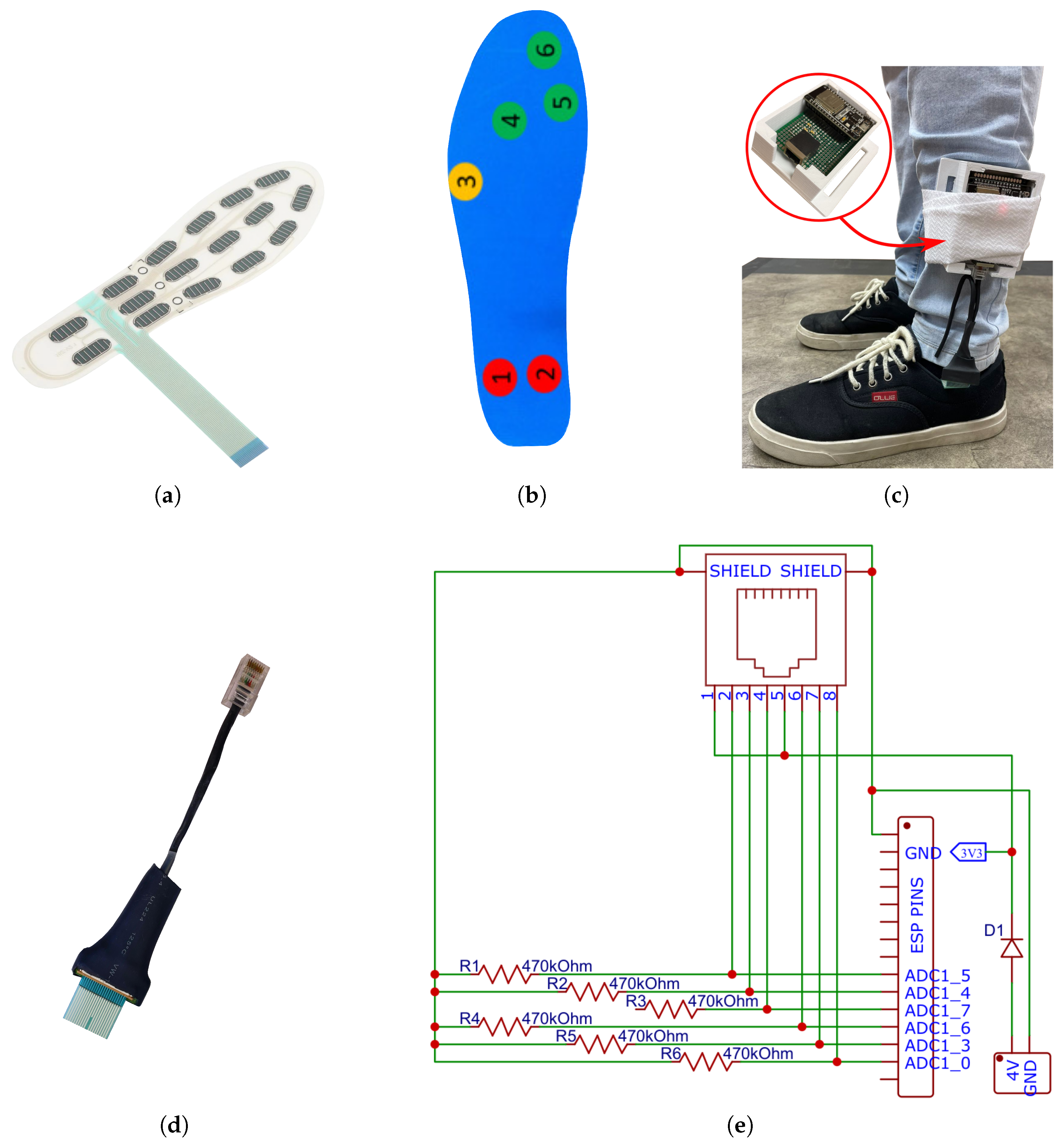
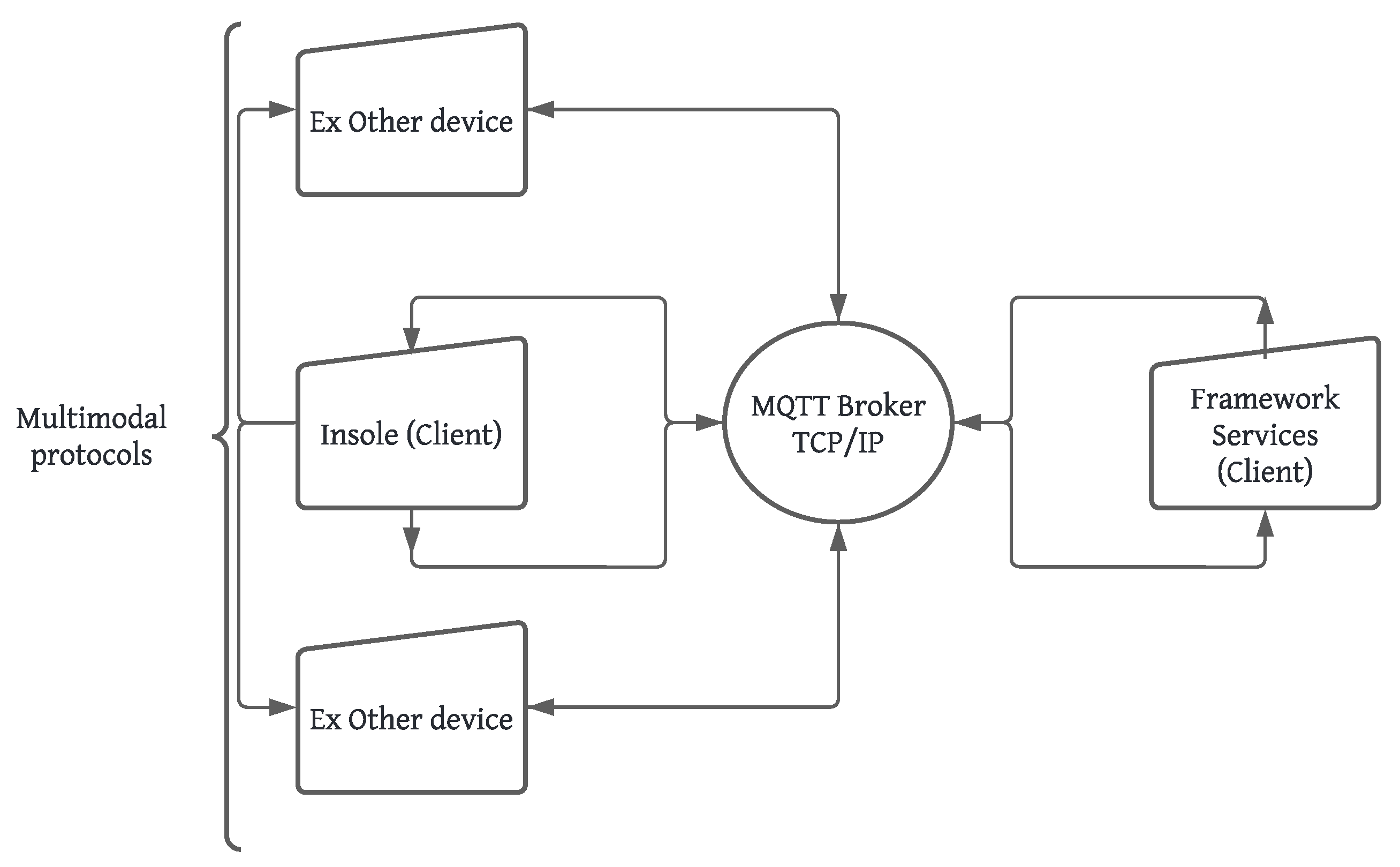
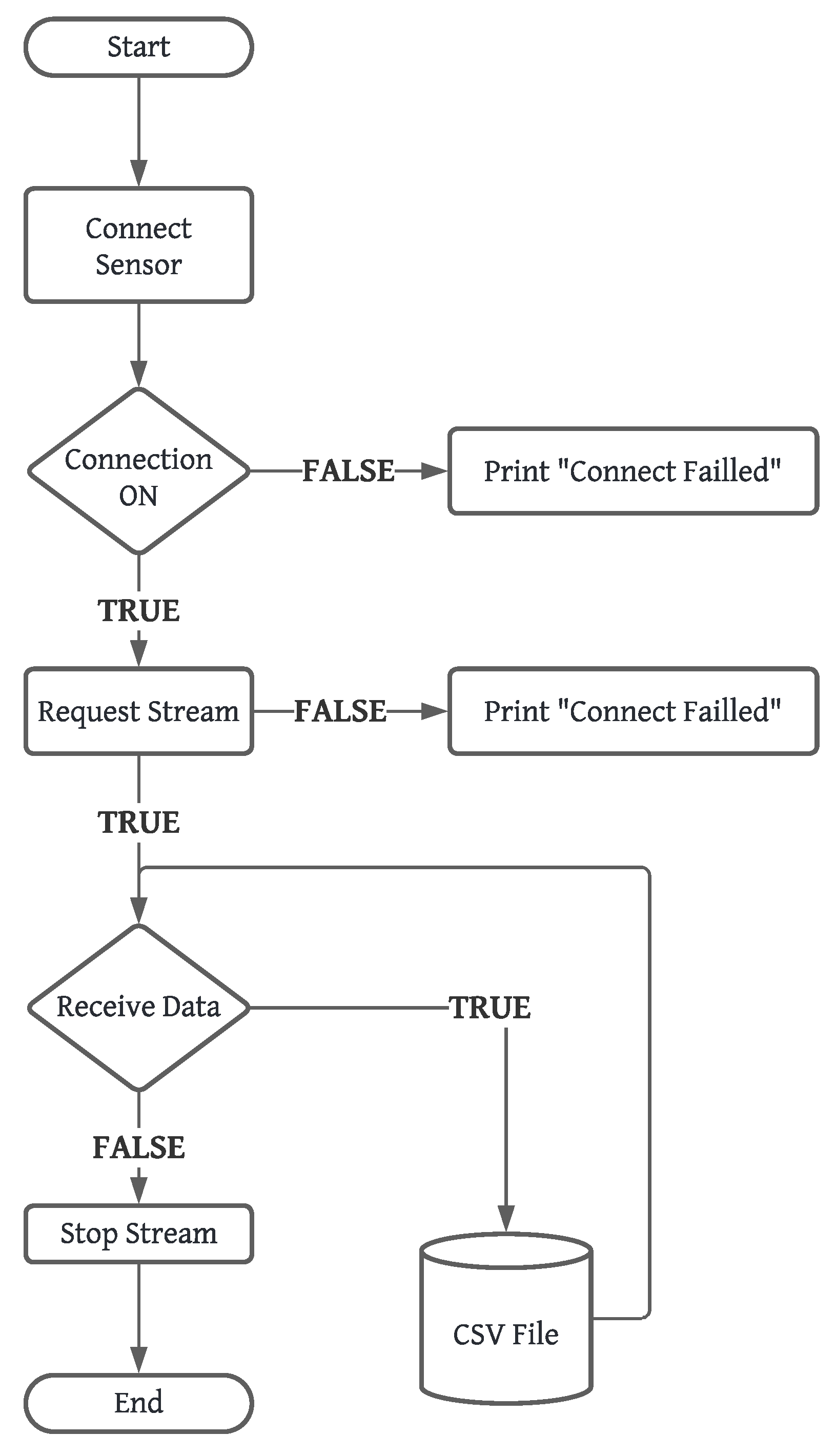
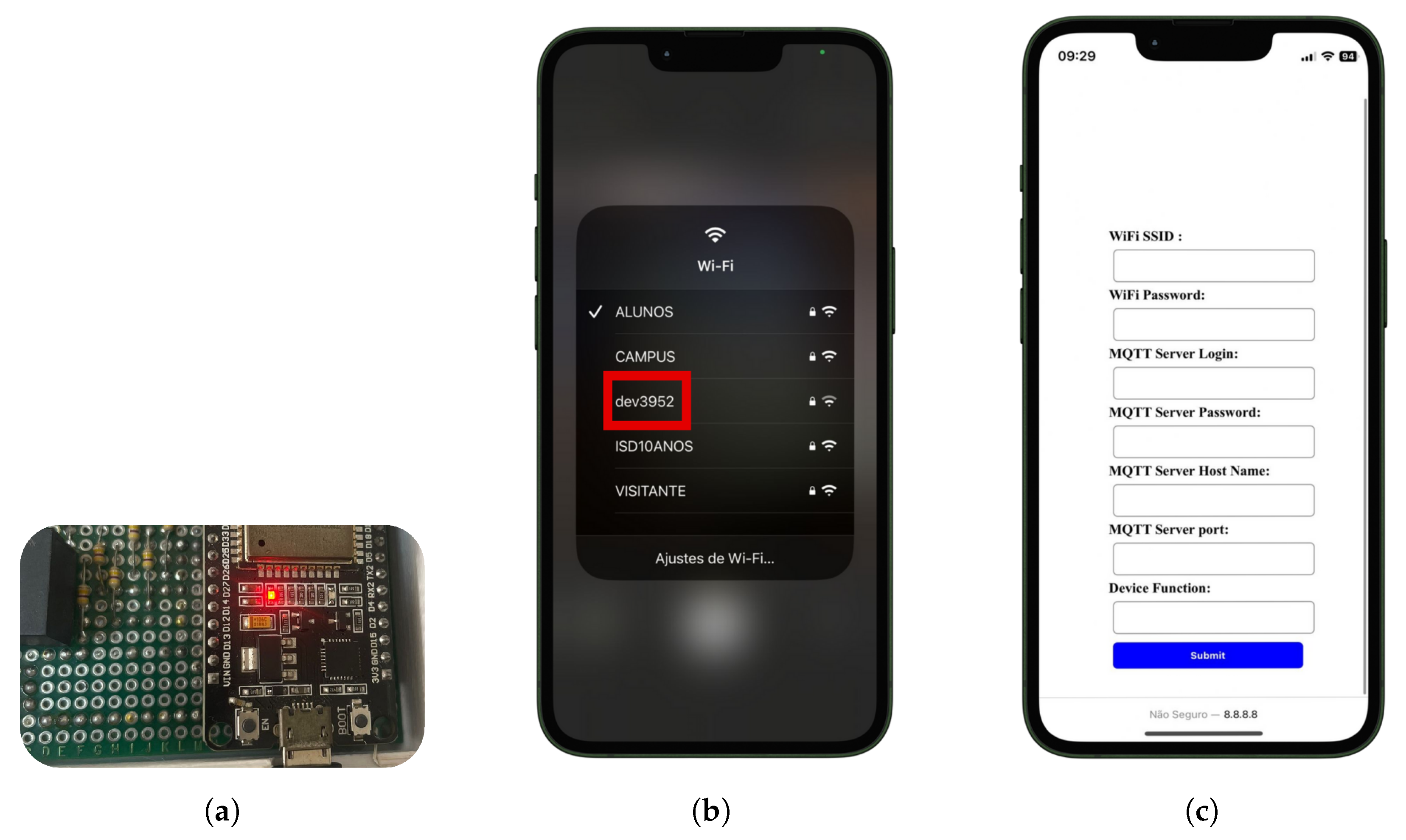
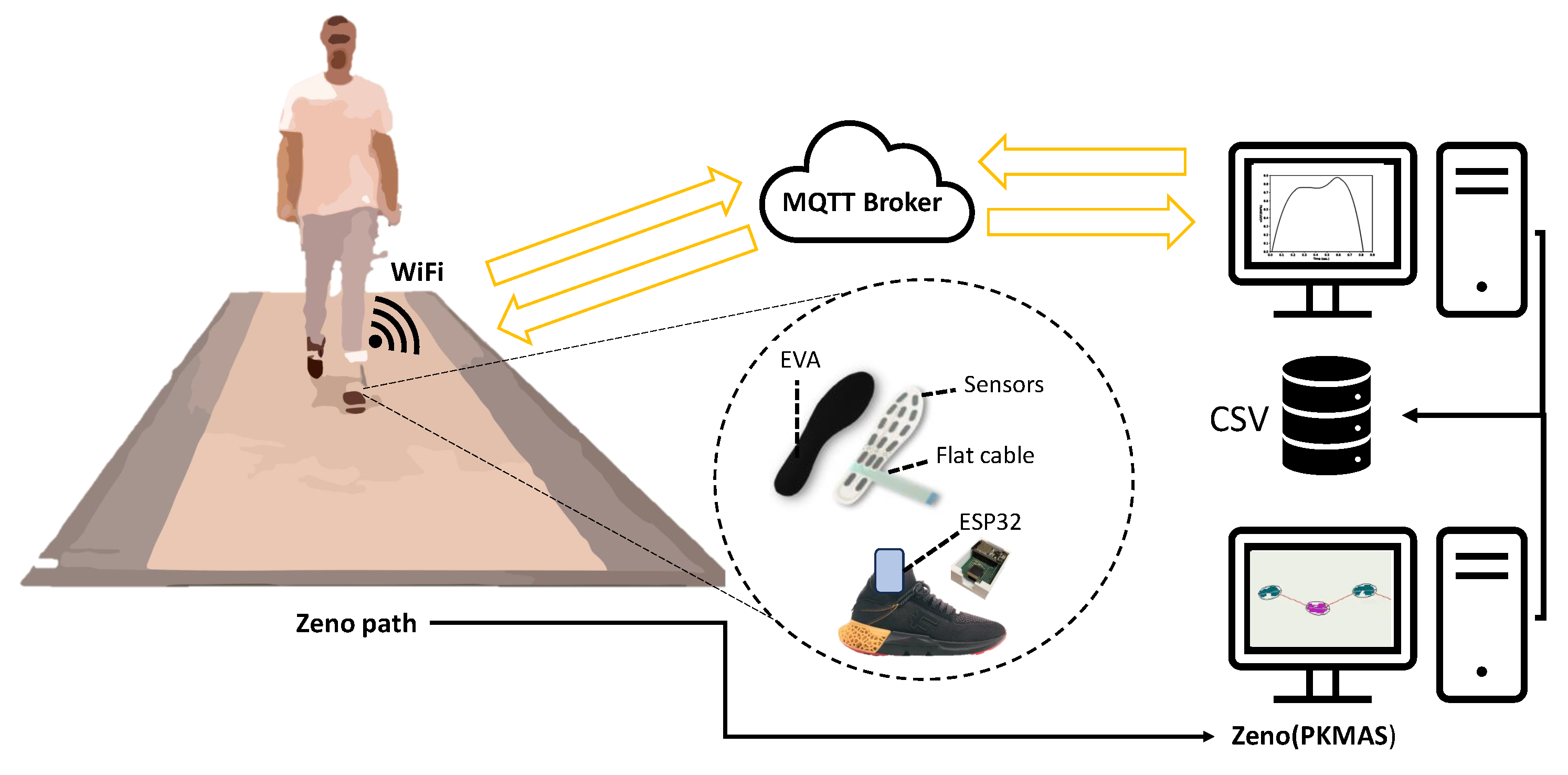

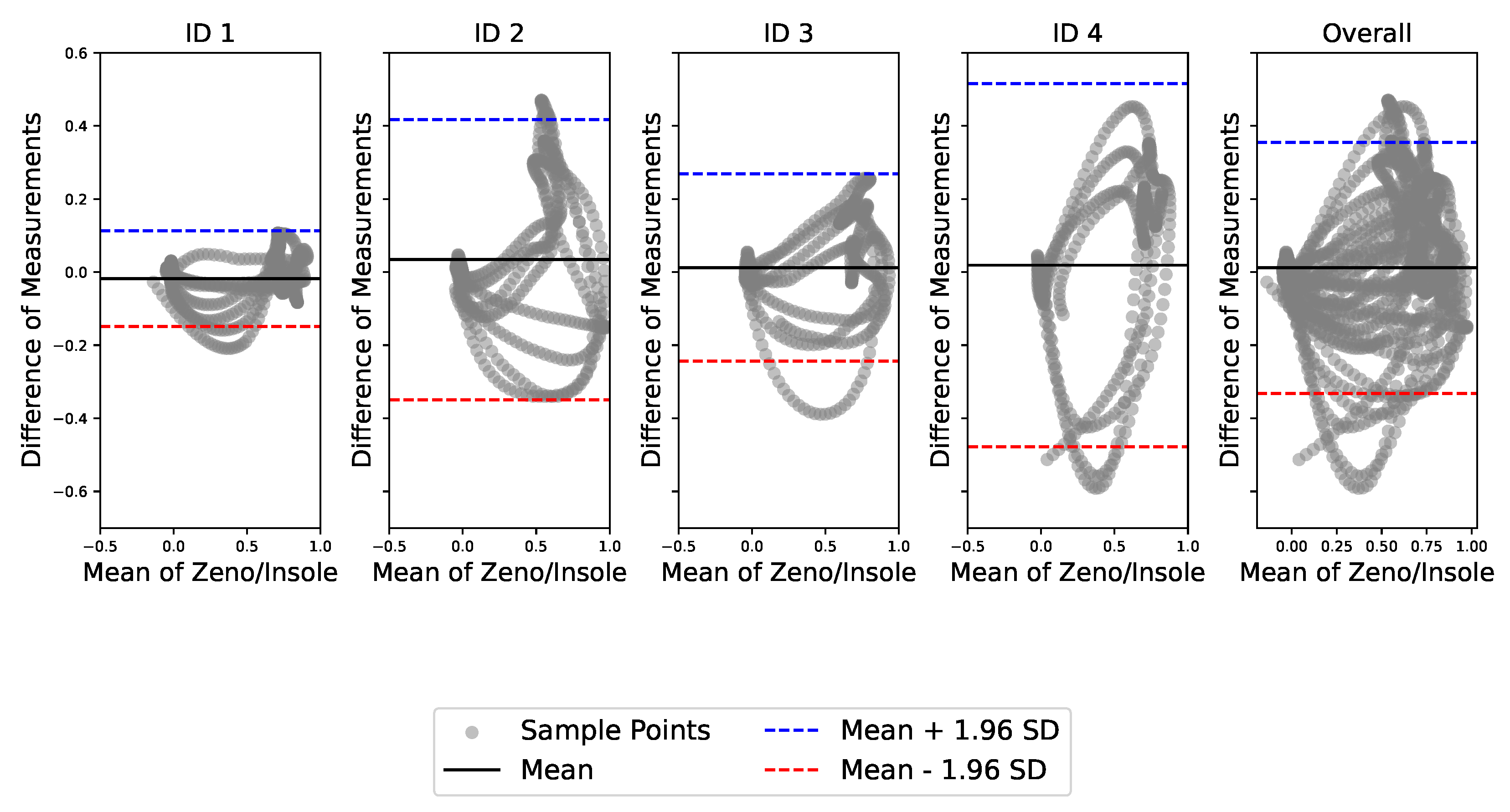

| Characteristic | Value |
|---|---|
| Pressure range | 0.5–10 kg |
| Action mode | Compression |
| Activation force | 500 g |
| Activation time | <10 ms |
| Operating temperature | −20 °C to +65 °C |
| Response time | <10 ms |
| N | Mean | SD | SE | Coefficient of Variation | |
|---|---|---|---|---|---|
| Zeno | 2160 | ||||
| Insole | 2160 | ||||
| Wilcoxon signed-rank | |||||
| Measure 1 | Measure 2 | W | z | df | p |
| Zeno | Insole | 732,384.000 | - | <0.001 | |
Disclaimer/Publisher’s Note: The statements, opinions and data contained in all publications are solely those of the individual author(s) and contributor(s) and not of MDPI and/or the editor(s). MDPI and/or the editor(s) disclaim responsibility for any injury to people or property resulting from any ideas, methods, instructions or products referred to in the content. |
© 2024 by the authors. Licensee MDPI, Basel, Switzerland. This article is an open access article distributed under the terms and conditions of the Creative Commons Attribution (CC BY) license (https://creativecommons.org/licenses/by/4.0/).
Share and Cite
Rathke, C.L.; Pimentel, V.C.d.A.; Alsina, P.J.; do Espírito Santo, C.C.; Dantas, A.F.O.d.A. IoT-Based Wireless System for Gait Kinetics Monitoring in Multi-Device Therapeutic Interventions. Sensors 2024, 24, 5799. https://doi.org/10.3390/s24175799
Rathke CL, Pimentel VCdA, Alsina PJ, do Espírito Santo CC, Dantas AFOdA. IoT-Based Wireless System for Gait Kinetics Monitoring in Multi-Device Therapeutic Interventions. Sensors. 2024; 24(17):5799. https://doi.org/10.3390/s24175799
Chicago/Turabian StyleRathke, Christian Lang, Victor Costa de Andrade Pimentel, Pablo Javier Alsina, Caroline Cunha do Espírito Santo, and André Felipe Oliveira de Azevedo Dantas. 2024. "IoT-Based Wireless System for Gait Kinetics Monitoring in Multi-Device Therapeutic Interventions" Sensors 24, no. 17: 5799. https://doi.org/10.3390/s24175799
APA StyleRathke, C. L., Pimentel, V. C. d. A., Alsina, P. J., do Espírito Santo, C. C., & Dantas, A. F. O. d. A. (2024). IoT-Based Wireless System for Gait Kinetics Monitoring in Multi-Device Therapeutic Interventions. Sensors, 24(17), 5799. https://doi.org/10.3390/s24175799







